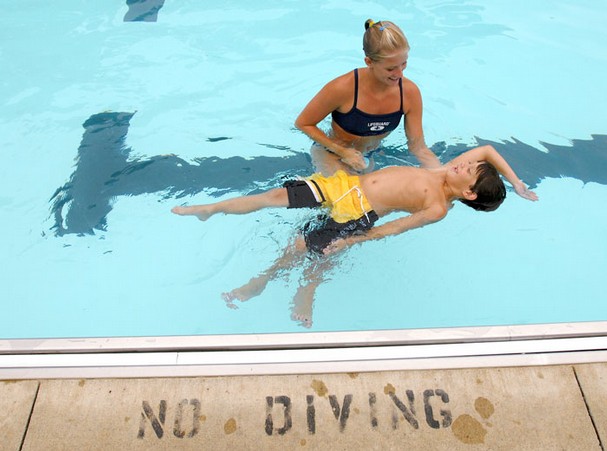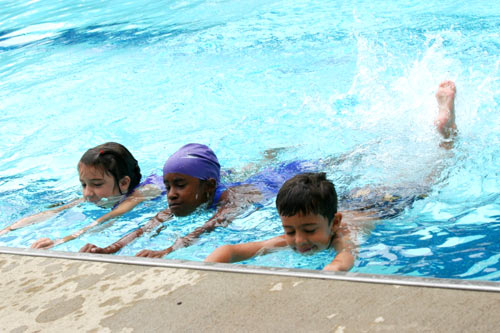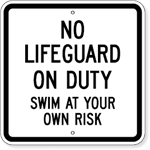Column: Safety at the deep end of the pool
September 10th, 2011 Posted in OpinionOne of the most frightening things for any parent surely would be their own child drowning. I’m no parent, but the idea of anyone drowning is enough to put you on edge. Yet there are still parents who don’t seem to understand the dangers of water, especially at a public pool.
 I’ve been a lifeguard for nearly four years, and I have luckily avoided major pool-related catastrophes. In fact, all of the saves I have seen have been relatively minor, but looking back, I realize that the greatest cause of dangerous situations at the pool is parents who neglect to watch their kids closely.
I’ve been a lifeguard for nearly four years, and I have luckily avoided major pool-related catastrophes. In fact, all of the saves I have seen have been relatively minor, but looking back, I realize that the greatest cause of dangerous situations at the pool is parents who neglect to watch their kids closely.
Note to the parents
Obviously, lifeguards are there to help maintain safety. But this doesn’t mean they are there to babysit. Dangerous situations often occur when parents drop their kids into the shallow end of the pool and take a nap on the deck, expecting everything to be OK. Lifeguards aren’t babysitters, and even if we are paying extra close attention to little swimmers, parents should know where their kids are and keep an eye on them.
Parents, there are more people and kids in the pool than just your child. At any one time, a lifeguard is in charge of watching 10 swimmers or more. If they are too busy keeping an eye on one kid, another person could get injured. On more than one occasion, I have had to jump into the shallow end to rescue a 5-year-old who wanders into 4-feet-deep water. Is that your daughter?
I’m not saying that parents are terrible for not being in the water with their kids at all times, and I’m not telling parents how to raise their children. Parents should keep in mind that a public pool is a very busy place where something can go wrong in a manner of seconds.
A note on water safety
If it’s too much trouble to watch your child, invest in swimming lessons. The whole focus of swimming lessons is teaching kids how to be safe in the water and, essentially, how to save themselves when they get into trouble.
 I’ve given swimming lessons for two years, and one skill I think would be important for anyone to learn is how to float. If all a kid learns is how to float and tread water, that could be enough to save his life. At the Sports Academy in Logan, swimming teachers spend at least 5 to 10 minutes teaching kids how to jump into deep water, float on their backs and call for help.
I’ve given swimming lessons for two years, and one skill I think would be important for anyone to learn is how to float. If all a kid learns is how to float and tread water, that could be enough to save his life. At the Sports Academy in Logan, swimming teachers spend at least 5 to 10 minutes teaching kids how to jump into deep water, float on their backs and call for help.
My boss at the Sports Academy told me about a 4-year-old whose parents had been paying for lessons. While they were boating, the little girl fell into the water without a life jacket. The mother stopped her husband from jumping in after the girl and, sure enough, the girl rolled onto her back and kicked back to the boat where her dad could reach down and grab her.
Keep in mind that teaching kids how to be safe around and in the water is great, but also teaching kids how to get help or how to deal with certain situations is even better.
Unfortunately, many parents teach their kids to fear the water. I’ve taught many children who are afraid to put their faces in the water because they were told it would hurt them. Instead, kids need to be shown how to blow bubbles to stop water from getting in their mouth and nose.
Teaching kids to fear water can do more harm than good, and it takes a long time to break them of the idea that all water is dangerous. One of my co-workers gave private lessons for a pair of siblings, a boy and girl who were around 10 and 11 who had never been to a swimming pool before. Getting them put their faces in the water took at least a week, but they did improve a little after a month.
If at first you don’t succeed
 Even with swimming lessons, there are some kids who don’t understand how things work. They have a hard time floating or they are deathly afraid of putting their face in the water. The worst thing any parent can do is to stop the lessons. If a child has to repeat the same swimming level over three or more times, it doesn’t mean they fail.
Even with swimming lessons, there are some kids who don’t understand how things work. They have a hard time floating or they are deathly afraid of putting their face in the water. The worst thing any parent can do is to stop the lessons. If a child has to repeat the same swimming level over three or more times, it doesn’t mean they fail.
One 4-year-old boy started his lessons with me by refusing to put his face in the water; he was scared of floating without me holding him. At the Sports Academy, lessons are split into 8-day sessions. This little boy didn’t pass the first session, but by the end of the second session he was having me count how many seconds he could float on his back by himself and asking to swim to me on his own.
So don’t give up. Some children learn better when they get older or if they have time to build a trust with the teacher. Pulling a child out of swimming lessons because they “show no improvement” is a terrible idea. Kids need time to learn—after all, it takes us over a year to learn how to talk and walk as infants. Some kids need that much time to understand how to be safe in the water.
Swimming should be enjoyable and parents shouldn’t have to worry about their kids at the pool or lake. If you play it smart, that shouldn’t be a problem.
TP
Tags: lifeguard, pool safety, Swimming lessons

Sorry, comments for this entry are closed at this time.